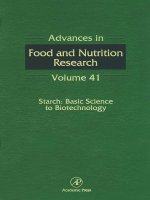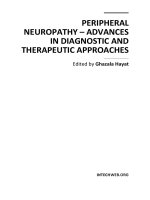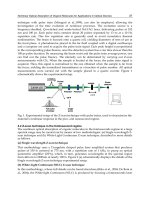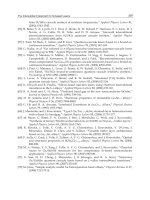advances in diabetes and pregnancy
Bạn đang xem bản rút gọn của tài liệu. Xem và tải ngay bản đầy đủ của tài liệu tại đây (177.32 KB, 17 trang )
International Diabetes Center
Advances in Diabetes and
Pregnancy
International Diabetes Center
Gestational Diabetes
•
Part 1: Epidemiology, etiology and
pathophysiology of diabetes
–
new classifications/definitions
–
incidence, prevalence, morbidity and mortality
–
causal factors associated with the development of GDM
–
natural history
•
Part 2: New therapeutic principles and
approaches from the perspective of SDM
–
detecting the underlying defect
–
determining the natural history
–
matching therapy to defect
•
Part 3: After GDM: the insulin resistance
syndrome
International Diabetes Center
Gestational Diabetes Mellitus
•
Once believed to be a unimportant event in pregnancy
•
Initially believed to be a predictor of type 2 diabetes, now
believed to be early type 2 diabetes
•
A combination of increased insulin production with decreased
utilization due to insulin resistance
•
Human placental lactogen production further exacerbates
insulin resistance
•
Over nourishment of the fetus through “shunting”
•
Maternal insulin does not pass placental barrier
•
Excess fetal growth due in part to over stimulated fetal
pancreas
•
Estimated to complicate 5% of all pregnancies
New
International Diabetes Center
Gestational Diabetes:
Epidemiology
0
20,000
40,000
60,000
80,000
100,000
120,000
140,000
160,000
GDM
cases
undetected
morbidity-poor
control
morbidity-tight
control
International Diabetes Center
Screening and Diagnostic Criteria
for GDM
SCREENING
•
50 gram Glucose Challenge Test
–
1 hour > 140 mg/dL (7.8 mmol/L)
DIAGNOSIS
•
100 gram Oral Glucose Tolerance Test (OGTT)
–
Fasting > 95 mg/dL (5.3 mmol/L)
–
1 hour > 180 mg/dL (10.0 mmol/L)
–
2 hour > 155 mg/dL (8.6 mmol/L)
–
3 hour > 140 mg/dL (7.8 mmol/L)
•
75 gram Oral Glucose Tolerance Test
–
Fasting > 95 mg/dL (5.3 mmol/L)
–
2 hour > 140 mg/dL (7.8 mmol/L)
•
One abnormal value ?
International Diabetes Center
Natural History of Gestational Diabetes
0
50
100
150
200
250
300
< 13 <2 7 27 29 31 33 35 37 39-41 post
del
50
100
150
Weeks
Weeks
Insulin Resistance
Insulin Level
Fasting Glucose
Post Meal Glucose
At risk for GDM
©2000 International Diabetes Center. All rights reserved
©2000 International Diabetes Center. All rights reserved
Glucose
Glucose
(mg/dL)
(mg/dL)
% of Normal Function
% of Normal Function
HPL
GDM
GCT OGTT
International Diabetes Center
Insulin Resistance (Due to HPL or
Underlying Type 2 Diabetes)
Insulin Sensitive Cells
Nucleus
G
G
G
G
G
G
G
G
G
G
G
G
G
G
G
G
G
G
G
G
G
G
Insulin
Glucose
Insulin
Receptor
Glucose
Transporter
(GLUT 4)
G
HLP
G
G
G
G
G
G
G
G
G
G
International Diabetes Center
Diabetes Therapies: matching
action to underlying defect
Medical Nutrition Therapy
Oral Agents
–
Insulin Secretegogues
•
Sulfonylurea- Glyburide
Insulin
–
Bolus/pre-meal insulin (Regular, Lispro,
Aspart)
–
Basal/background insulin (NPH, Lente,
Ultralente, Glargine)
New
International Diabetes Center
Medical Nutrition Therapy*
•
Action
–
Emphasis on BG control, not
weight loss
–
Carbohydrate counting
–
Prevention of weight gain in
obese women
–
Increased physical activity
•
Clinical Indicators
–
Insulin Deficiency/Insulin
Resistance
–
BMI - no range
–
BG range <120 mg/dL (6.7
mmol/L) if used as monotherapy
–
Always used as an adjunct therapy
with pharmacological agents
•
Side effects
–
None
•
Precautions and
Contraindications
–
Kidney Disease: low protein
diet for macroalbuminuria
–
Liver Disease: none
–
Heart Disease: assess fitness
before initiating activity program
•
Pregnancy
–
Alter diet and activity to promote
normal fetal development and
avoid fetal and maternal stress
*Self-monitoring of blood glucose and urine ketones (R/O starvation) are
essential components of MNT
International Diabetes Center
SDM GDM Master DecisionPath
Overview
Fasting < 95 mg/dL
(5.3 mmol/L)
Casual < 120
mg/dL
(6.7 mmol/L)
Fasting < 95 mg/dL
(5.3 mmol/L)
Casual < 120
mg/dL
(6.7 mmol/L)
Medical Nutrition Stage
Focus on carbohydrate foods (portions
and number/meal)
Encourage physical activity/exercise
Medical Nutrition Stage
Focus on carbohydrate foods (portions
and number/meal)
Encourage physical activity/exercise
30 mg/dL
(1.7 mmol/L)
Entry Criteria Therapies Lowers BG
International Diabetes Center
Insulin Secretagogues: Glyburide
•
Action
–
Release of insulin from
pancreas in response to a
glucose challenge
•
Clinical Indicators
–
Insulin Deficiency
–
*Mean BG <150 mg/Dl (8.3
mmol/L)
–
*High postprandial BG 120 –
180 mg/dL (6.7-10.0 mmol/L)
•
Side effects
–
Weight gain
–
Hypoglycemia
•
Precautions and
Contraindications
–
Kidney Disease: SU-use
caution;
–
Liver Disease: Use
caution, not well studied
with liver disease
–
Known hypersensitivity to
the drug
•
Pregnancy
–
All other oral agents pass
the placental barrier
New
*Label indicates average glucose lowering 60 mg/dL (3.3 mmol/L)
International Diabetes Center
Beta cells produce insulin and
store it in secretory vesicles
ATP
ATP
ADP
ADP
Pyruvate
Pyruvate
Voltage-gated
Calcium Channel
Ca
Ca
++
++
Ca
Ca
++
++
G
G G
G
G
G
Glucose
Transporter
(Glut 2)
G
G
G
G
G
G
G
G
G
G
G
Potassium
Channel
K
+
Insulin Secretagogues: Beta Cell
Function
G
K
+
K+ Channel Blocked- membrane becomes depolarized
K+ Channel Blocked- membrane becomes depolarized
X
X
International Diabetes Center
SDM GDM Master DecisionPath
Overview
Fasting < 95 mg/dL
(5.3 mmol/L)
Casual < 120 mg/dL
(6.7 mmol/L)
HbA1c NA
Fasting < 95 mg/dL
(5.3 mmol/L)
Casual < 120 mg/dL
(6.7 mmol/L)
HbA1c NA
Medical Nutrition Stage
Medical Nutrition Stage
30 mg/dL
1.7 mmol/L
Entry Criteria Therapies
Oral Agent Stage
Oral Agent Stage
Fasting > 95 mg/dL
(5.3 mmol/L)
Casual > 120 mg/dL
(6.7 mmol/L)
HbA1c NA
Fasting > 95 mg/dL
(5.3 mmol/L)
Casual > 120 mg/dL
(6.7 mmol/L)
HbA1c NA
Insulin Deficiency
Glyburide
BG
60 mg/dL
3.3 mmol/L
International Diabetes Center
Insulin
•
Action
–
Compensates for diminished
beta cell secretion of insulin
–
Overcomes insulin resistance in
peripheral tissue
–
Suppresses gluconeogenesis
•
Clinical Indicators
–
Insulin Deficiency/Insulin
Resistance
–
BMI-no specific range
–
HbA1c N.A.
–
FPG >95 mg/dL (5.3 mmol/L)
–
CPG >120 mg/dL (6.7 mmol/L)
•
Side effects
–
Hypoglycemia
–
Weight gain
•
Precautions and
Contraindications
–
Kidney Disease: none
–
Liver Disease: none
–
Heart Disease: none
•
Pregnancy
–
Therapy of choice in GDM
when FPG is high, when
HbA1c >8% or uncertain of
type 1 diabetes
International Diabetes Center
0
10
20
30
40
50
0 2 4 6 8 10 12 14 16 18 20 22 24
Normal Insulin Secretion
Serum insulin (mU/L)
Serum insulin (mU/L)
Time (Hours)
Meal
Meal
Meal
Meal
Meal
Meal
Basal Insulin Needs
Basal Insulin Needs
Bolus insulin needs
Bolus insulin needs
SDM GDM Master DecisionPath
Overview
Oral Agent Stage
Glyburide
Oral Agent Stage
Glyburide
Fasting < 95 mg/dL
(5.6 mmol/L)
Casual < 120 mg/dL
(6.7 mmol/L)
Fasting < 95 mg/dL
(5.6 mmol/L)
Casual < 120 mg/dL
(6.7 mmol/L)
Medical Nutrition Stage
Medical Nutrition Stage
Fasting >95 mg/dL
(5.6 mmol/L)
Casual > 120 mg/dL
(6.7 mmol/L)
HbA1c NA
Fasting >95 mg/dL
(5.6 mmol/L)
Casual > 120 mg/dL
(6.7 mmol/L)
HbA1c NA
Entry Criteria Therapies Lowers BG
Note: Each stage
Note: Each stage
requires a pre-set
requires a pre-set
target and a
target and a
timeline to reach
timeline to reach
that goal
that goal
Insulin Stage
Physiologic Insulin Stage 4
RA-RA-RA-N
Conventional Insulin Stages 2 or 3
30 mg/dL
1.7 mmol/L
60 mg/dL
3.3 mmol/L
>60 mg/dL
>3.3 mmol/L
International Diabetes Center
GDM, Type 2 Diabetes and
Metabolic Syndrome
•
Is GDM really type 2 diabetes in
pregnancy?
•
Does GDM always lead to type 2 diabetes
after pregnancy?









